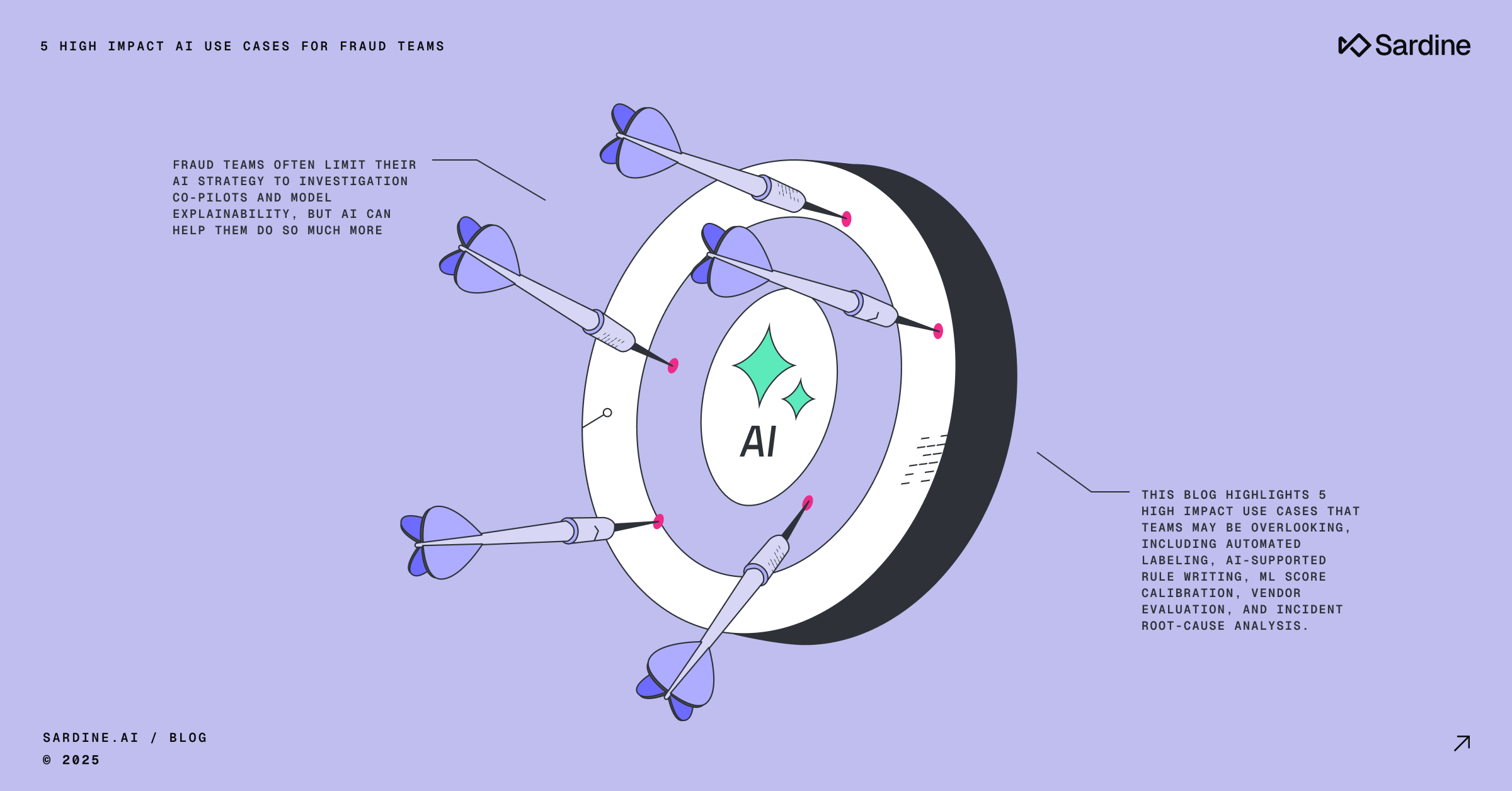Eight steps to Building World-Class Account Management
When you get account management right, it becomes the critical link between customer, product, and growth. We’ve identified eight steps to building a world-class account management team and shared them below.
Our account management team and setup have received incredible feedback from clients like:
“Thanks for your collaboration in fighting this fraud attack. This has been a massive help. All of the fraudsters have received the message that they can’t get onto our platform anymore.”
❤ Anon Client
“I’ve worked with a bunch of transaction monitoring companies and I’m having a really positive experience with Sardine. I mean I worked at WorldPay, and have never seen this level of detail and partnership!”
❤ Anon Client
“What sets Sardine apart is how knowledgeable the team is regarding fraud signals and technical minutiae around the data and the ability of the Sardine team to look at novel activity and quickly and efficiently turn around analysis.”
❤ Anon Client
Account Management is critical in areas like Fraud and Payments, where the landscape is constantly changing:
Account management is where product meets customer outcome.
Sardine is a fraud prevention and payments company.
Our SaaS product enables Fintech companies and E-Comm businesses to monitor and respond to real-time fraud and money laundering changes. The platform helps construct sophisticated heuristics around identity, device, and payment data.
While our product design eliminates some of the complexity involved in analyzing and acting on these data, the success of our product ultimately hinges on customers making informed and confident decisions with the tool.
With this in mind, we’ve devoted significant thought and resources to building a world-class account management team that ensures our customers succeed in solving their end goals with Sardine’s tools. While we still have a lot of work ahead of us to achieve our ultimate account management goals here are a few pieces of our framework that help us deliver for clients:
1. Build a client “north star” document during the sale process
Before a customer can begin integrating with Sardine, we require a kickoff call where a sales engineer and integrations engineer collaborate with the customer to build a ‘customer scope’ statement.
This statement encapsulates everything they want to solve with Sardine, and this document is our north star throughout the subsequent integration and onboarding process. Similarly, we’ve defined the life cycles of sales to integrations to account management that clearly outlines roles and responsibilities.
2. Account Managers act as thought partners and special agents
An account manager at Sardine interacts daily with a dozen customers and several internal teams. Each account manager owns the success of their customers, and we serve as their internal stakeholder within Sardine.
We act as an extension of our customers, assisting with things like:
- Data Analysis: Help a customer evaluate the tradeoffs between conversion and fraud rate in a decision to implement a rule or threshold — explore avenues for improving the precision/recall of a rule or model.
- Fraud expertise: Explain a new fraud MO seen across the Sardine network and how the customer can monitor for suspicious activity that aligns with the new pattern using our anomaly detection tools.
- High-level business processes: walk a customer through what an efficient compliance decisioning pipeline looks like.
- External facing PM: Take a product request and boil down the urgency and value with the customer — work with the customer on the ‘minimum viable product’, which will most likely get the green light from Sardine’s PMs.
Because these tasks are highly multifaceted, our hiring process is as well ⬇️
3. Make ‘attitude’ a hiring metric
We’ve found folks who effectively help customers achieve their goals can 1) take complicated problems and distill them into a series of simple actions and 2) quickly master new knowledge domains and apply them to novel problems.
The process for assessing individuals for 1) is two-fold:
- Analysis and distillation of objective data — can a candidate take a complex and multifaceted task and compute X,Y,Z computational problems and arrive at explainable insights? And
- Subjectively how well did the candidate deliver the message, how persuasive were they, did the candidate show curiosity, novel insights, etc.
When hiring, we evaluate a candidate’s attitude towards new challenges — how they approach new problems as they arise, especially if it requires a complete change of gears. We look for tenacity and perseverance in our candidates — if we can confidently use these words to describe them, they meet our ‘attitude’ standards.
Lastly, we test for resilience. Customers sometimes throw curveballs or thorny/uncomfortable questions at account managers — we try to pepper these in the interview process to see that the candidate can find an elegant path forward and remain unfazed.
4. Run a constant feedback loop between Account and Product Management for prioritization and tracking.
Every Thursday, Sardine’s account management and product teams meet.
Sardine strictly adheres to a ‘less meetings, more productivity’ mantra, so we only have weeklies when we believe they add net value.
Before the meeting, account managers update any product feature request tickets they have. During the meeting, we review new tickets and progress on existing tickets with our head of product. This ensures:
- The product team truly understands product asks and the reason for urgency, if any
- The account management team gets immediate feedback on the feasibility of new product requests and an idea of when they will be prioritized in a sprint, and
- How existing product requests are progressing
This meeting arms account management with extremely quick feedback on customer product requests and helps keep product and engineering accountable. It creates a forum among all AMs and PMs to discuss and evaluate customer requests. As we continue to grow in scale, we will continue to streamline this process while keeping the core objectives in place.
5. Enable Multiple Customer Communication Channels
At Sardine, we think about customer comms with one high-level metric:
What is the ‘friction’ for customers to reach out to us?
Our goal is to keep friction as low as possible.
This has led us to support several different communication channels with customers: We have shared Slack channels with customers (for a slight support cost that most customers are more than happy to pay), in-dashboard ticketing, and of course, email.
While maintaining hundreds or thousands of Slack channels could be burdensome, we’ve developed an efficient system that integrates our customer’s slack channels with ZenDesk and allows for easy ticket creation and tracking.
6. Engineer a feedback loop between account management and sales
At Sardine, sales and account management are highly collaborative. We have a slack channel for internal feedback between our groups and a monthly meeting to discuss what’s working and what’s not working in relation to our respective team’s goals. A few benefits:
- Account managers can update sales on new fraud attacks we see across the network and how we’ve quelled them — this often prepares sales for what they will see in their conversations with customers
- Sales may ask account management to prioritize a case study relating to a specific use case that they see a lot of interest in
Quickly close the gap on any issues, for instance, maybe a new pricing structure was implemented, and the account managers are seeing that customers may not have fully grasped how it works during sales conversations
7. Continuously review customer requests to prioritize documentation updates
The account management team gets plenty of questions about everything from API endpoints to technical feature deep dives daily. So we built an Asana board to track common customer asks that could be solved by adding additional or improved documentation to our site.
This drives continuous improvement to our docs and diminishes repetitive tasks, which creates long-term efficiency for account managers — instead of being bogged down by recurring tasks, we get to continually focus on novel problems.
8. Always do what’s right for the customer, not revenue
While this is self-explanatory and may seem cliche, we’ve made “always do what’s right for the customer, not revenue” an organizational manifesto. This ensures that when anyone at Sardine faces a decision where this could apply, everyone is 110% aligned on which path to take.
Conclusion
We’d love to hear your thoughts and questions on anything here; looking forward to giving a status update in a few months.
Also, if you’re a current customer, tell us how we can do better? We strive to give customers an exponential change in value, and your feedback is everything to us.



%20(1).png)





.png)

